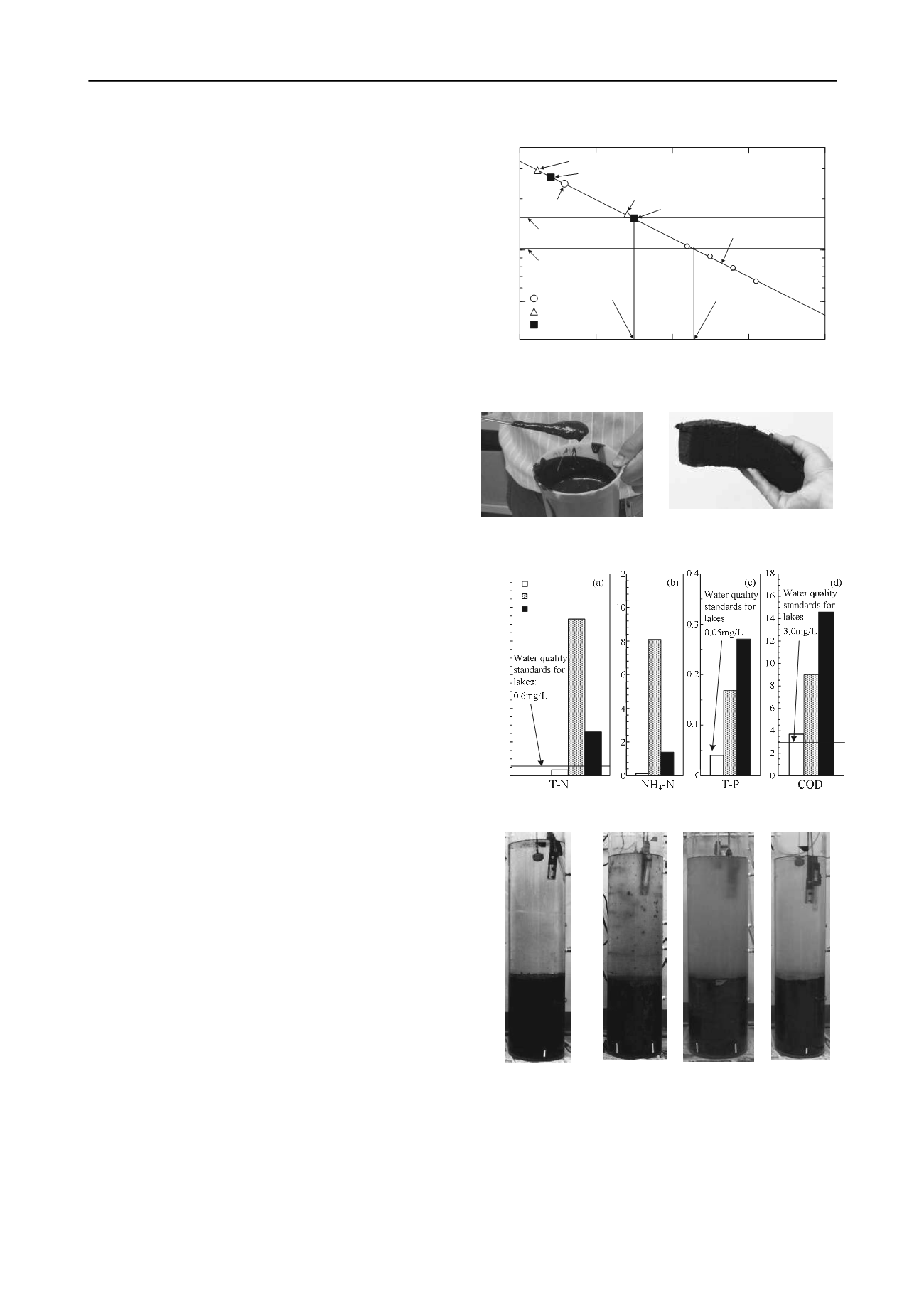
3083
Technical Committee 215 /
Comité technique 215
mud. A dissolved oxygen amount (DO) meter and oxidation
reduction potential (ORP) meter were installed, and the top of
the column was covered with a lid. Then, by the aeration of
nitrogen gas near the bottom, lake water became an anaerobic
condition (DO<1 mg/L), in which nutrient salts were released
easily from bed mud. During the test, discharge of a slight
amount of nitrogen gas was continued near the water surface to
maintain an anaerobic condition. Circulation of lake water was
performed. Tests were continued through 80 days. To verify the
release inhibition effect, water quality analysis was conducted
during a fixed period. All tests were conducted in a thermostatic
chamber with room air temperature of 23±1°C in which the
fluorescent light was illuminated continuously.
4 TEST RESULTS AND DISCUSSIONS
4.1
Volume reduction and removal of nutrient salts through
dehydration
The relation of the water content
w
and the consolidation
pressure
p
obtained from the consolidation tests is shown in
Figure 4. A normal consolidation line was also obtained from
the consolidation test using incremental loading. Initial water
contents of the bed mud,
w
i
, were about 300% (Cases A and B).
Furthermore, it is a slime-like condition as shown in Photo 2(a).
The water content after adding natural zeolite powder,
w
i
*
,
decreases slightly (Case C). However in Cases B and C, by
application of 30 kPa of low consolidation pressure, the relation
between
w
and
p
is almost identical. The volume decreased to
about two-thirds and the water content becomes about
w
L
. The
bed mud condition changes to a moderate consistency with
flexibility by self-weight (see Photo 2(b)). The bed mud with
w
L
has workability for reclamation. Furthermore, it is expected that
a suitable environment for living things on the bottom and
realize inhibition of nutrient salts (see 2(3) and 2(4)). If 200 kPa
of consolidation pressure is applied, then the water content
becomes about
w
P
. The condition with
w
P
is hard and flexibility
passes away. The consolidation pressure of the filter press,
which is generally used to dehydration work, is too high. Using
a simple dehydration machine, the countermeasure cost can be
curtailed.
Figures 5(a)
–
5(d) show contents of T-N, T-P, NH
4
-N, and
COD in the drainage water and lake water. In Case B without
natural zeolite, these contents are 28, 62, 4.2, and 2.4 times of
lake water respectively, the nutrient salts in bed mud can be
removed with drainage water. For Case C with natural zeolite
powder, they are, respectively, 7.9, 11, 6.8, and 3.9 times. The
contents of T-N and NH
4
-N decrease to about one-fourth and
one-sixth of Case B because of the adsorption effect of natural
zeolite. The values of T-N, T-P, and COD are larger than those
of water quality standards for lakes in Japan. However, the
contents of all cases are much smaller than in original bed mud
(Table 2). The values of contents in bed mud for Cases B and C
differ only slightly from the initial value.
4.2
Release inhibition of nutrient salts from bed mud
The conditions of lake water at the initial stage and after 40
days are presented in Photos 3(a)
–
3(d). The lake water at the
beginning of test is almost clear (Photo 3(a)). In Cases A and B
without natural zeolite powder, the lake water gradually
becomes turbid (Photos 3(b) and 3(c)). In Case A with no
treatment, algae begin to increase in the lake water after about
20 days; the color becomes green. After 40 days, the luxuriance
of algae reaches a peak, with adhesion of algae on the inner
surface of container (Photo 3(b)). The algae in the column are
cyanobacteria, which generate oxygen by photosynthesis
because of increase in DO from 30 days, which is not shown.
After about 60 days, the green water gradually pales. In Case B,
which was dehydrated by consolidation, algae regarded as
cyanobacteria increase and the lake water color changes as well
as Case A (Photo 3(c)). However algae are not observed on the
container inner surface. In Case C, to which was added natural
zeolite powder and dehydrated by consolidation, algae cannot
be found in the lake water, and the lake water color changes
only slightly (Photo 3(d)).
1
10
100
1000
10000
50
100
(log scale)
(log scale)
Consolidation pressure
p
(kPa)
Water content
w
(%)
0
=160.3%
w
L
=155.0%
w
P
=102.0%
Bed mud in Lake Suwa
﴾
w
i
=255.0 295.6%)
0
=152.0%
≈
31 kPa
i
=295.6%
w
i
*
=270.8%
Case A
Case B
Case C
Normal consolidation line
400
≈
200 kPa
i
=255.0%
Figure 4. Relation between water content and consolidation pressure.
(a) Initial condition
(b) Dehydrated bed mud (Case C)
Photo 2. Dehydration of bed mud by consolidation.
0
2
4
6
8
10
12
14
16
18
COD
0
0.1
0.2
0.3
0.4
T-P
0
2
4
6
8
10
12
NH4-N
0
2
4
6
8
10
12
T-N
Lake water
Case B
Case C
Contents of nutirent salts (mg/L)
Figure 5. Nutrient salt contents in drainage water.
(a) Initial condition (b) Case A (c) Case B (d) Case C
Photo 3. Test results obtained after 40 days.


